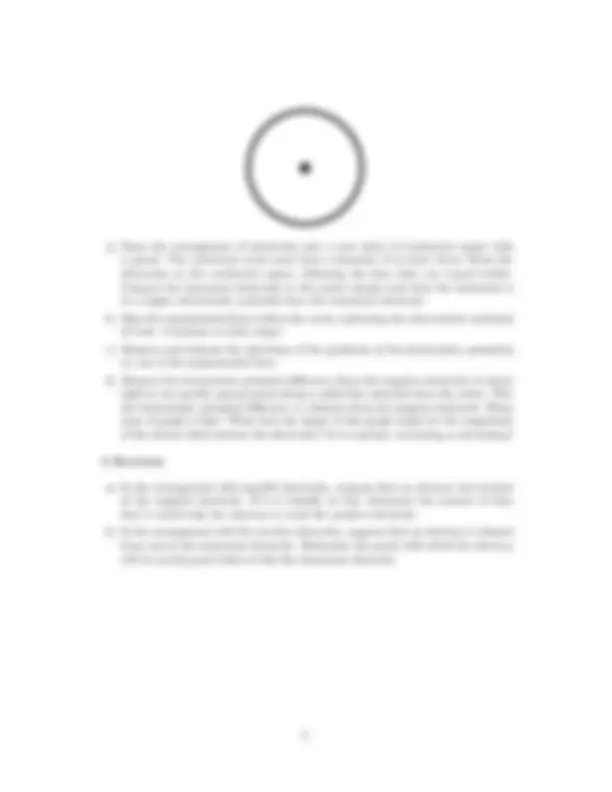



Study with the several resources on Docsity

Earn points by helping other students or get them with a premium plan


Prepare for your exams
Study with the several resources on Docsity

Earn points to download
Earn points by helping other students or get them with a premium plan
Community
Ask the community for help and clear up your study doubts
Discover the best universities in your country according to Docsity users
Free resources
Download our free guides on studying techniques, anxiety management strategies, and thesis advice from Docsity tutors
Material Type: Lab; Class: Electromagnetism and Optics-GTSC1; Subject: Physics; University: Mesa State College; Term: Spring 2008;
Typology: Lab Reports
1 / 3

This page cannot be seen from the preview
Don't miss anything!


Phys 132L Spring 2008
In one dimension, the electric field and the electrostatic potential are related via either
V (x 1 ) − V (x 2 ) = −
∫ (^) x 2
x 1
Edx (1)
or
E = − dV dx
There are analogous relationships for three dimensional cases. Of the two quantities the electrostatic potential is far easier to measure and the entire electrostatic potential landscape can be mapped using a voltmeter. Once the landscape is mapped Eq. (2) can be invoked to determine the electric field. An important additional rule, inferred from Eq. (2), is that the electric field points opposite to the gradient of the electrostatic potential and that these gradients are perpendicular to equipotential lines, i.e. lines along which the electrostatic potential is constant. The aim of this laboratory is to investigate these relationships and to exploit them to determine the electric fields produced by various arrangements of charge distributions.
1 Electrostatic Potentials and Electric Fields: Parallel Conductors In this part of the experiment you will investigate the electrostatic potentials and the electric fields produced by parallel conductors. Each conductor, or electrode, will be connected to one terminal of the output of a power supply.
a) The electrodes will eventually be drawn onto a sheet of conductive paper (black paper with a grid) using an ink pen that contains silver ink particles suspended in a solvent. Using a light colored pencil trace, on a conductive sheet, two parallel lines extending along the length of the sheet and separated by 6 cm. The electrodes will be drawn on top of these lines. b) When used properly the conductive (silver) ink pen can produce highly conductive lines. Vigorously shake the conductive ink pen (with the cap on) for 10-20 seconds to disperse any particle matter suspended in the ink. You should be able to hear something moving inside the pen while you do this. c) Drawing with the pen requires simultaneously depressing the tip of the pen and squeezing the barrel of the pen. Practice doing this on a piece of scrap paper until you can produce a continuous silver line of approximately uniform width. d) Draw the electrodes on the conductive paper, following the lines that you traced earlier. It is essential that the electrodes are continuous; any break will disrupt the conductivity.
e) Configure the power supply so that it provides a DC voltage between 5.0 V to 15 V. Connect one terminal of the output to one electrode and the other to the other electrode. f) Use the voltmeter to measure the electrostatic potential difference between two widely separated points on the same silver electrode. Repeat this for the other electrode. g) Measure the electrostatic potential difference between two points, one on each of the electrodes. Try this at a few different locations. Note the extent to which this varies.
In the following parts you will measure electrostatic potentials relative to that of the negative electrode, which is that at the lower potential. Throughout these part, you will hold the “COM” voltmeter probe on the negative electrode while varying the position of the other probe in the gap between the negative and positive electrode, which is that at the higher potential.
h) Place the other voltmeter probe on the positive electrode and slowly drag it across the gap between the two electrodes. Comment on the behavior of the electrostatic potential as you do this. Does it change continuously or jump? Does it increase, decrease or fluctuate up and down as you cross the gap? i) Map at least 10 points on any single equipotential line in the gap between the two electrodes. Draw the equipotential curve that passes through these points and label the value of the electrostatic potential on this curve. Repeat this for five approximately equally spaced equipotential lines. Comment on the shape of these curves. j) The gradient of electrostatic potential is the direction in which the electrostatic potential increases most rapidly and is parallel to the electric field. To measure the gradient tape the two probes together so that their heads are not touching and remain fixed close distance apart. With this configuration, place the pair of probes at several locations along one equipotential line and determine the direction of the gradient of electrostatic potential. Indicate this with arrows on the sheet. k) Measure the electrostatic potential difference (from the negative electrode) at about eight to ten equally spaced points along a line perpendicular to the electrodes. Record electrostatic potential differences and the distances from each point to the negative electrode. Plot the electrostatic potential difference vs. distance from the negative electrode. What type of graph is this? What does the shape of this graph imply for the magnitude of the electric field between the electrodes? Determine the magnitude of the electric field between the electrodes.
2 Electrostatic Potentials and Electric Fields: Circular Conductors The same approach can be applied to any arrangement of conductors. In this part of the experiment you will investigate the fields and potentials produced by conductors arranged as illustrated.